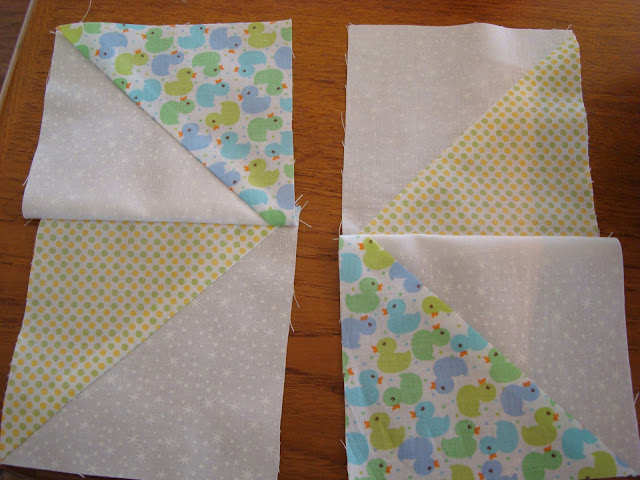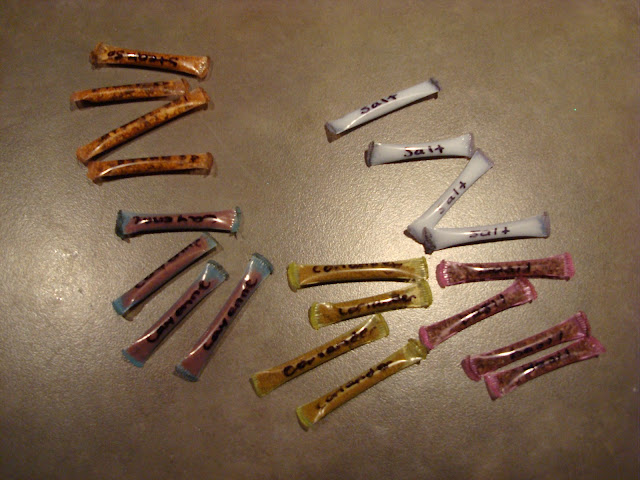One of the ladies in my class is having a baby soon so I decided this time instead of crocheting a baby blanket since that takes such a long time, I would quilt it. Also I haven't had a chance to quilt in a while and I love doing so.
To start off you will need some different fat quarters of cotton in various colours as well as white. For this blanket I had 7 patterns that match, white and then a few metres if plain light green for the backing and small details.
Since I do not have a quilter's mat and rolling cutter I do it the old fashioned way by cutting a template out of a thinner cardboard. Usually if you have an old cereal box kicking around it will work nicely. Corrugated board I find is sometimes too thick to get the same precision. Be very neat and precise with your measurements and make sure you use a ruler to get straight lines.
I cut out three different pieces. The triangle piece measures 14cmx 14cm (5.5"x 5.5") This piece was for the main parts of my pinwheels. I wanted 2 different coloured patterns for each pin wheel with the while in between. So to do this I cut 48 white triangles and 48 coloured ones (8 triangles each of 6 different patterns).
The second piece I cut out was a rectangle that was 7 cm (2 3/4") by 22 cm (8 3/4") These you will need 17 pieces of. I originally cut them out in white like in the picture but then I found this was too stark against the pinwheels so I went back and cut them out of a coloured fabric.
The last piece I made was a square that was 7cm by 7cm (2 3/4" x 2 3/4") I cut 6 of these pieces out of the same fabric I used for my backing.
Materials
7 cotton colours in fat quarters
White (maybe about 1m will be plenty for everything you need
Quilting batting about 36"x48" (I like the one made of bamboo, but there are many blends)
cotton fabric in the colour you choose to back the blanket about 36" x 48"
Tips
Keep 1 cm seam allowance throughout, always
Press every-time between steps
Be precise
Process
Step 1: Cut cardboard templates out. Then trace them with a pencil on the WRONG side of the fabric. Make sure you are very precise about this. Cut out the pieces very carefully. Keep the triangles in pairs of two.
Step 2: Match up two different patterned pairs with 4 white triangles. This will be the basis of your pinwheel.
Step 3: Stitch each coloured triangle to a white one. Put RIGHT sides together and stitch along the hypotenuse of the triangle. When done iron/press them flat and make sure the seam is pressed behind the darker colour. Cut the "dog ears" off of the square.
Step 4: Now you should have 4 squares for each pinwheel. Arrange them so that the colours are alternating with the white. Like colours should be across from each other. (see pictures) Stitch 2 squares together. Repeat with the last two squares.
Step 5: Press the seams again then stitch the two rectangles together to form your first pinwheel. Press. Repeat steps 2-5 for the remaining 11 pinwheels.
Step 6: Arrange your pinwheels in the pattern that you like the best. It should have 3 across by 4 down. Then in between each row of 3 pinwheels, stitch a rectangle bar. (Eg. It will go pinwheel, bar, pinwheel, bar, pinwheel) do this for all 4 rows.
Step 7: With your remaining rectangles stitch them to the squares in this pattern: bar, square, bar, square, bar. Press flat.
Step 8: Attach each of the three skinny bar strips to the pinwheel rectangles that you already have. One set of pinwheels will not have a strip on it.
Step 9: Sew two strips together then sew the other two together. Then join together to form your completed quilt topper. The reason you do it bit by bit like this is so that if there are little mistakes in alignment they can be absorbed into the pattern easier. If you started at one end instead you would have a huge difference in measurement once you reached the other end of the quilt. This is especially noticeable on adult size blankets.
Step 10: Press your quilt topper. Then sew it to some quilt batting. Cut off excess batting around edges after. (I usually leave about an inch around the edge of batting) Place this on top of your backing fabric. Measure and cut around so it is the same size. Stitch it together. Use leftover scraps to create a bit of a bias tape that you sew around edges to clean them up. My strips were about 7.5 cm (3") wide so that I had enough to have about 2.5 cm (1") on each side and then the remaining inch was tucked under on each side.
Step 11 FINISHING: If you have a quilters or embroidery foot, this is where you can quilt all the layers together in a free flow pattern of your choice. These "feet" block the feed dogs so that the fabric can be moved all around. If you do not have one of these (like me) then there are a few options:
1. You can either stitch in the groove between fabrics.
2. You can make a straight pattern back and forth over quilt.
3. You can join the layers together with tufts of embroidery thread or yarn every few squares. Thread the yarn/thread through all layers of the quilt and tie ends on the top half.
The reason you do this is that it joins all the layers besides just on the edge. This makes it a lot easier to wash.
The second piece I cut out was a rectangle that was 7 cm (2 3/4") by 22 cm (8 3/4") These you will need 17 pieces of. I originally cut them out in white like in the picture but then I found this was too stark against the pinwheels so I went back and cut them out of a coloured fabric.
The last piece I made was a square that was 7cm by 7cm (2 3/4" x 2 3/4") I cut 6 of these pieces out of the same fabric I used for my backing.
Materials
7 cotton colours in fat quarters
White (maybe about 1m will be plenty for everything you need
Quilting batting about 36"x48" (I like the one made of bamboo, but there are many blends)
cotton fabric in the colour you choose to back the blanket about 36" x 48"
Tips
Keep 1 cm seam allowance throughout, always
Press every-time between steps
Be precise
Process
Step 1: Cut cardboard templates out. Then trace them with a pencil on the WRONG side of the fabric. Make sure you are very precise about this. Cut out the pieces very carefully. Keep the triangles in pairs of two.
Step 2: Match up two different patterned pairs with 4 white triangles. This will be the basis of your pinwheel.
Step 3: Stitch each coloured triangle to a white one. Put RIGHT sides together and stitch along the hypotenuse of the triangle. When done iron/press them flat and make sure the seam is pressed behind the darker colour. Cut the "dog ears" off of the square.
Step 4: Now you should have 4 squares for each pinwheel. Arrange them so that the colours are alternating with the white. Like colours should be across from each other. (see pictures) Stitch 2 squares together. Repeat with the last two squares.
Step 5: Press the seams again then stitch the two rectangles together to form your first pinwheel. Press. Repeat steps 2-5 for the remaining 11 pinwheels.
Step 6: Arrange your pinwheels in the pattern that you like the best. It should have 3 across by 4 down. Then in between each row of 3 pinwheels, stitch a rectangle bar. (Eg. It will go pinwheel, bar, pinwheel, bar, pinwheel) do this for all 4 rows.
Step 7: With your remaining rectangles stitch them to the squares in this pattern: bar, square, bar, square, bar. Press flat.
Step 8: Attach each of the three skinny bar strips to the pinwheel rectangles that you already have. One set of pinwheels will not have a strip on it.
Step 9: Sew two strips together then sew the other two together. Then join together to form your completed quilt topper. The reason you do it bit by bit like this is so that if there are little mistakes in alignment they can be absorbed into the pattern easier. If you started at one end instead you would have a huge difference in measurement once you reached the other end of the quilt. This is especially noticeable on adult size blankets.
Step 10: Press your quilt topper. Then sew it to some quilt batting. Cut off excess batting around edges after. (I usually leave about an inch around the edge of batting) Place this on top of your backing fabric. Measure and cut around so it is the same size. Stitch it together. Use leftover scraps to create a bit of a bias tape that you sew around edges to clean them up. My strips were about 7.5 cm (3") wide so that I had enough to have about 2.5 cm (1") on each side and then the remaining inch was tucked under on each side.
Step 11 FINISHING: If you have a quilters or embroidery foot, this is where you can quilt all the layers together in a free flow pattern of your choice. These "feet" block the feed dogs so that the fabric can be moved all around. If you do not have one of these (like me) then there are a few options:
1. You can either stitch in the groove between fabrics.
2. You can make a straight pattern back and forth over quilt.
3. You can join the layers together with tufts of embroidery thread or yarn every few squares. Thread the yarn/thread through all layers of the quilt and tie ends on the top half.
The reason you do this is that it joins all the layers besides just on the edge. This makes it a lot easier to wash.
 |
| Cut out pattern templates |
 |
| Trace pattern on WRONG side of fabric |
 |
| Match colours in groups of 2 |
 |
| Completed triangles |
 |
| Match each coloured triangle with a while one and stitch (Right sides together) |
 |
| Press flat with seam towards darker colour |
 |
| Remove dog ears |
 |
| Stitch 2 squares and 2 squares together |
 |
| Join the two rectangles together. Match the centre seams first! |
 |
| Press pinwheel flat. Trim edges a bit if they are uneven. |
 |
| Layout pinwheels with bars in between. Start stitching them in rows together. |
 |
| Join remaining bars with squares, press and sew between pinwheel bars. I changed my bars to a colour afterwards since I didn't like the white bars. |
 |
| Completed layout. Press. Attach quilt top to batting and backing. |
 |
| Sew strips around edges to finish off blanket. |
 |
| Finished Blanket |














